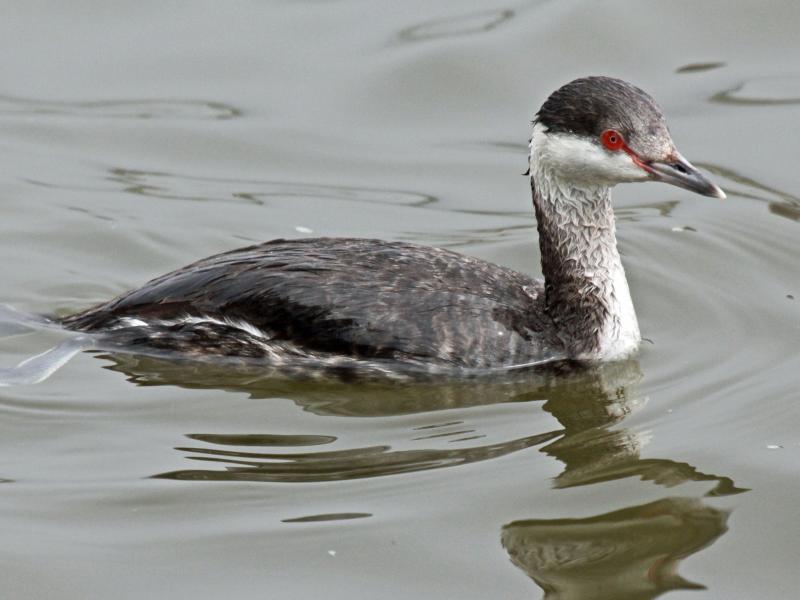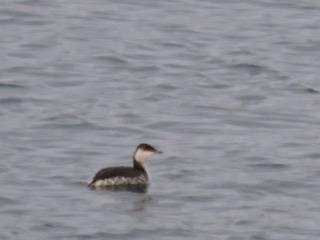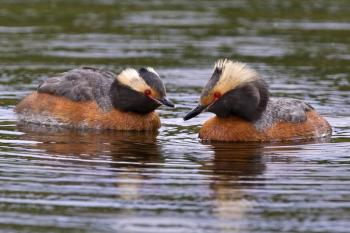Faithful reader Diane R. sent along a photo of a bird they had seen recently paddling around in tidal water just off the shore somewhere in the Midcoast area. They had questions about its identity and whether it should have been here or not.
The photo is a study in gray and white. Looking a bit like a tiny loon, it has a dark cap and a white cheek. Its neck was proportionately longer and thinner than a loon, though, and it had a much smaller and stubbier bill than a loon. Not very visible in the photo is the bird’s striking red eye.
The bird was a horned grebe sporting its subtle winter coat as do the loons here in winter too.
In the breeding season, the horned grebe is not so subtle, with golden feather tufts sticking up like horns on the side of its black head and a rich, rufous neck and sides. It’s a fancy looking little bird! Sometimes just before they leave us in April to head north for the summer, some will have molted fully in to this jazzy plumage, giving birders a feast for the eyes.
The grebe family was long-considered closely related to the loons as they have many similarities. But modern genetic analyses has suggested that they are more closely related to—ready?—flamingos! Who’d have guessed?
Pretty wild, especially when you consider that an estimated 79% of North America’s horned grebes nest in the Boreal Forest, from Alaska east to Ontario. The greatest concentrations are in the Northwest Territories, Yukon and interior Alaska, according to eBird map models. Within this area, horned grebes use the millions of lakes and ponds that make the Boreal Forest region one of the most wetland-filled places on Earth. They find shallow areas where they build up a mound of rotting vegetation into a tiny island on which they form a small depression and lay their clutch of up to eight eggs. Like in most grebe species (perhaps all, but we are not 100% certain), the downy chicks have a black and white zebra-striped head and pink bill.
Horned grebes migrate from the Boreal Forest breeding grounds to wintering areas largely along the Pacific, Atlantic, and Gulf coasts, but a few winter in open lakes and ponds in interior locations including in the Great Lakes. They have been found wintering as far south as the Florida Keys and into northern Mexico.
Horned grebes arrive in greatest numbers in Maine beginning in October, some stopping off at inland lakes until the waters begin freezing over. After November, most are found along the coast where it is not uncommon to see five to 10 in a single scan, in some productive areas. Most have disappeared by the end of April, but an occasional bird, perhaps an immature or one that is injured or sick, will remain into May or even into the summer.
Another subspecies of horned grebe nests across Eurasia. Both our North American subspecies and the Eurasian subspecies are classified by BirdLife International as Vulnerable because of apparent population declines over the last 30-50 years. Here in North America, there are only limited data available to assess whether populations have decreased because of the inaccessibility of much of their Boreal breeding range as well as the dispersed nature of the population across the wintering range.
Fortunately, some birders who do see them, like Diane R, take photos and share their observations!
Jeffrey V. Wells, Ph.D., is a Fellow of the Cornell Lab of Ornithology and Vice President of Boreal Conservation for National Audubon. Dr. Wells is one of the nation's leading bird experts and conservation biologists and author of the “Birder’s Conservation Handbook.” His grandfather, the late John Chase, was a columnist for the Boothbay Register for many years. Allison Childs Wells, formerly of the Cornell Lab of Ornithology, is a senior director at the Natural Resources Council of Maine, a nonprofit membership organization working statewide to protect the nature of Maine. Both are widely published natural history writers and are the authors of the popular books, “Maine’s Favorite Birds” (Tilbury House) and “Birds of Aruba, Bonaire, and Curaçao: A Site and Field Guide,” (Cornell University Press).































